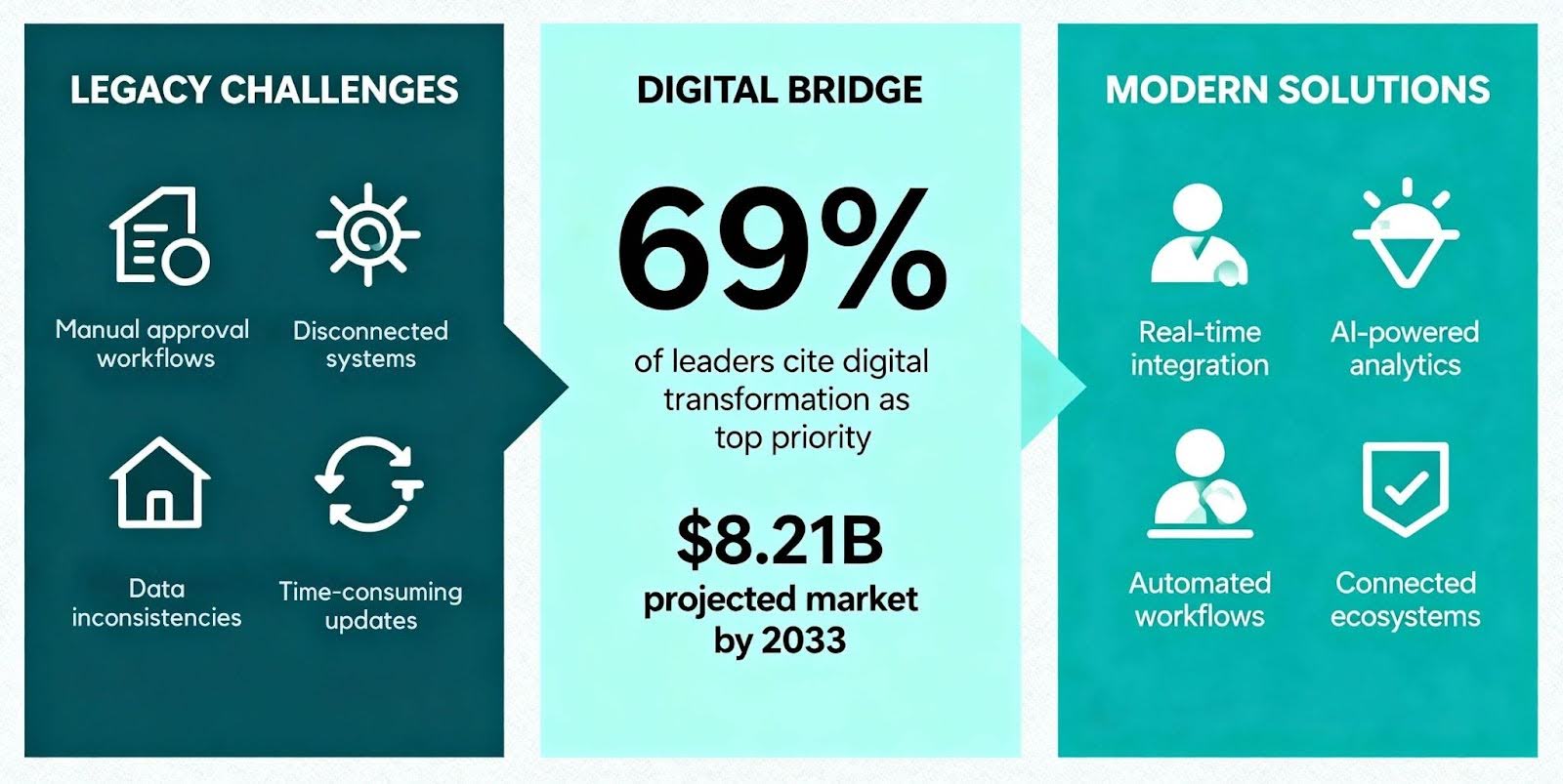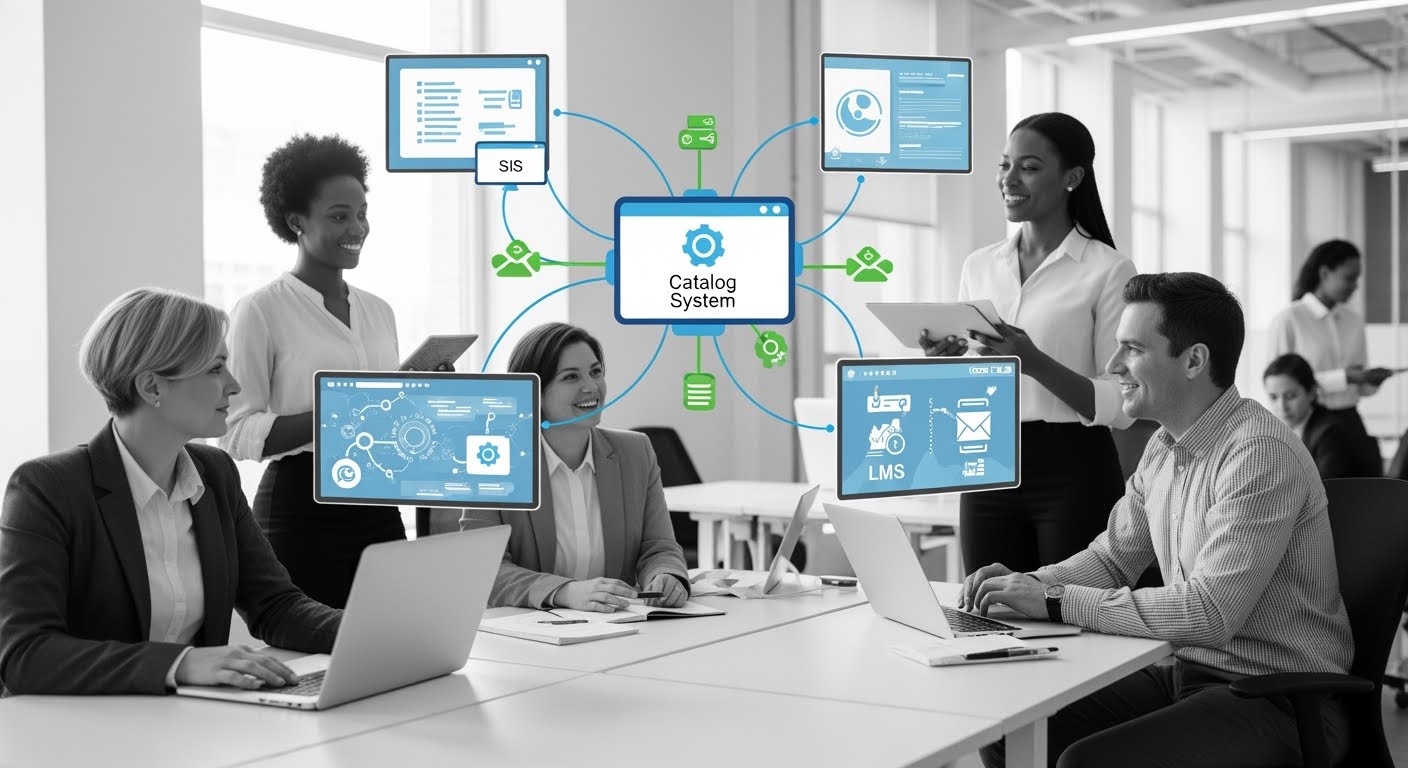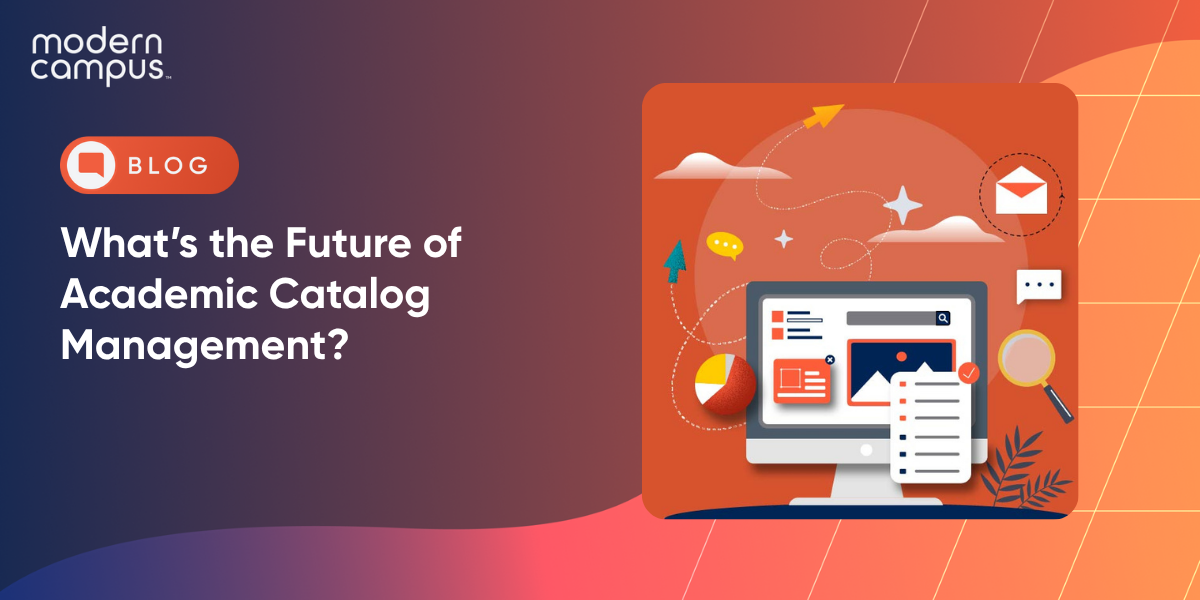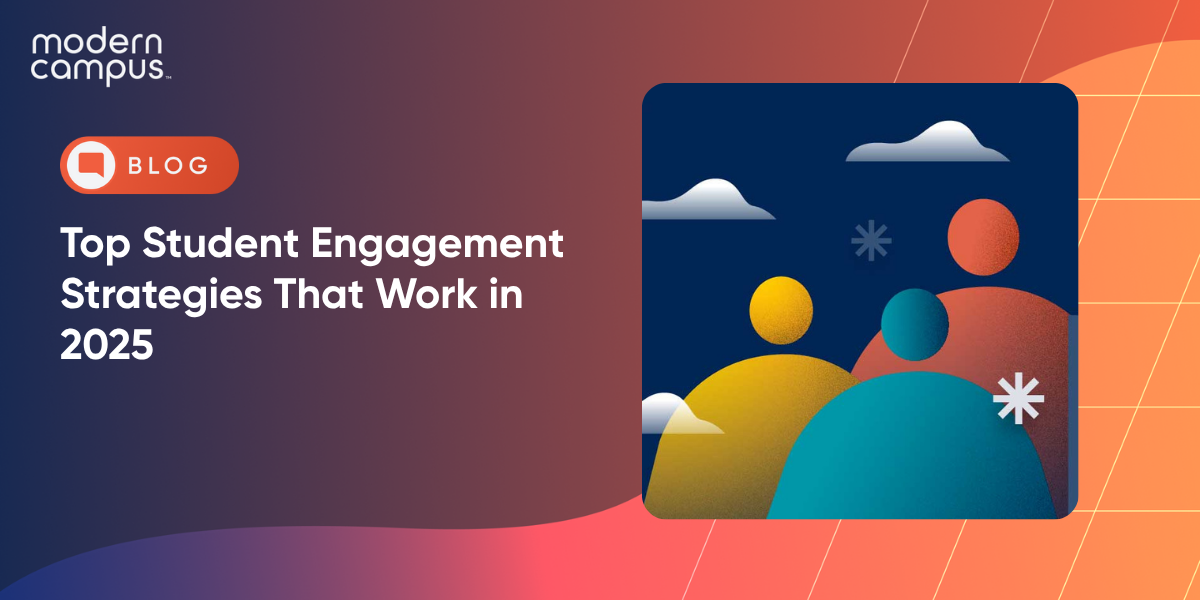What’s the Future of Academic Catalog Management?
Academic catalog management is shifting from legacy systems to cloud-based, AI-powered platforms that integrate seamlessly with existing institutional technology.
Key developments include:
- Real-time curriculum updates
- Predictive analytics for course planning
- Automated compliance tracking
- Personalized student pathways
Institutions investing in SaaS-based catalog solutions now will lead the digital transformation of higher education operations into the future.
From declining enrollments to shifting student expectations, institutions face mounting pressure to modernize their operations. Digital transformation in higher education has accelerated, with 69% of leaders citing it as one of their biggest challenges as of 2023. At the heart of this massive change lies a critical but often overlooked component: academic catalog management.
The traditional approach to managing course catalogs and curriculum information is buckling under the weight of modern demands. Manual catalog processes consume countless hours, create data inconsistencies and frustrate both staff and students. But the future promises intelligent systems that anticipate needs, automate workflows and create seamless experiences.
Why Is Academic Catalog Management at a Digital Crossroads?
The current state of academic catalog management reveals a sector caught between outdated processes and urgent modernization. Many institutions still rely on legacy course catalog software developed decades ago. Which means struggling with fragmented databases, manual approval workflows and disconnected platforms that fail to effectively communicate.
The Higher Education Catalog & Curriculum Management Software Market reached $3.67 billion in 2024, with projections at $8.21 billion by 2033. This 9.6% compound annual growth rate reflects institutions' recognition that their current systems can't support modern educational demands.
What Challenges Impact Modernization in Higher Education?
The challenges are multifaceted:
- Faculty spend excessive time navigating approval processes for curriculum changes.
- Registrars battle inconsistent data across multiple systems.
- Students struggle to find accurate, up-to-date information about their degree requirements.
Meanwhile, accreditation demands require increasingly sophisticated tracking and reporting capabilities that manual processes can't efficiently provide.
When catalog information is outdated or inconsistent, students make uninformed decisions about their academic pathways. Advisors provide guidance based on potentially incorrect information. Marketing efforts falter because promotional materials don't reflect current offerings. The entire institutional ecosystem suffers from these information gaps.
Institutions that continue relying on outdated catalog management approaches risk falling behind competitors who embrace integrated, automated solutions.
What Will Tomorrow's Academic Catalogs Look Like?
Leading academic catalog systems already incorporate artificial intelligence, real-time integration and personalized experiences, but these capabilities are evolving into even more sophisticated tools that will reshape higher education administration.
Generative AI adoption has reached 86% of education organizations, the highest rate for any industry. The next evolution will see these systems become even more predictive, analyzing patterns across thousands of student journeys to proactively identify optimal pathways for specific demographics or career goals before students even request guidance.
Real-time data integration, currently available in advanced platforms, will expand beyond basic synchronization. Tomorrow's systems will anticipate integration needs, automatically configuring new data flows when institutions add systems or modify processes. Instead of requiring manual setup for each connection, catalog platforms will intelligently map data relationships and suggest integration opportunities that administrators might not have considered.
Current predictive analytics capabilities that identify enrollment trends and flag potential bottlenecks will evolve into comprehensive institutional intelligence systems. These enhanced platforms will analyze historical patterns and incorporate external factors like labor market changes, demographic shifts and industry disruptions to provide strategic guidance for curriculum development and resource allocation.
The student experience, already personalized in leading systems through degree audit integration and pathway planning, will become increasingly anticipatory. Advanced catalog platforms will predict student needs based on subtle behavioral patterns, proactively surfacing relevant information and opportunities rather than waiting for students to search for them.
5 Game-Changing Trends Reshaping Academic Catalog Systems
Several technological and operational shifts are changing how institutions approach catalog management, moving from static, isolated systems to dynamic, interconnected platforms. Understanding these developments helps institutional leaders make informed decisions about their technology investments and operational strategies.

1. Cloud-First Infrastructure
The migration to SaaS solutions is the most prominent shift in academic catalog technology. Ninety-five percent of businesses now use SaaS solutions, with educational institutions recognizing the benefits of cloud-based platforms. Unlike legacy on-premises systems, modern course catalog software offers automatic updates, enhanced security and scalable performance that adjusts to institutional needs.
2. Predictive Analytics Integration
Advanced analytics offer a greater understanding of academic offerings for institutions. Modern catalog systems analyze enrollment patterns, completion rates and student success metrics to provide actionable insights. This data-driven approach enables institutions to make informed decisions about program modifications, resource allocation and strategic planning.
3. API-Driven Ecosystem Connectivity
The future belongs to interconnected systems. Academic catalog platforms increasingly offer robust Application Programming Interfaces (APIs) that seamlessly integrate with Student Information Systems, Learning Management Systems and scheduling platforms. This connectivity eliminates data silos and ensures consistency across all student-facing touchpoints.
4. Automated Compliance Management
Accreditation requirements and regulatory compliance demand sophisticated tracking. Next-generation catalog systems automatically monitor compliance metrics, generate reports and alert administrators to potential issues before they become problems. This automation reduces administrative burden while ensuring institutional accountability.
5. Student-Centric Experience Design
Modern catalog platforms prioritize user experience, offering intuitive interfaces that make academic information easily discoverable. Advanced search capabilities, mobile-optimized designs and personalized content presentation ensure students can quickly find the information they need to make informed academic decisions.
How Do SaaS Solutions Outperform Legacy Catalog Systems?
The advantages of cloud-based academic catalog management become apparent when examining operational efficiency, cost-effectiveness and scalability. Legacy systems, often built decades ago, struggle to meet contemporary demands for integration, accessibility and real-time functionality.

Cost Efficiency and Predictable Budgeting
Traditional on-premises systems require significant upfront investments in hardware, software licenses and IT infrastructure. Ongoing maintenance, security updates and system administration further inflate the total cost of ownership. SaaS solutions operate on predictable subscription models that include hosting, maintenance, security and support within transparent pricing structures.
Scalability Without Capital Investment
Legacy implementations face significant scalability challenges. As institutions grow or academic offerings expand, traditional systems often require expensive hardware upgrades or complete replacements. Cloud-based platforms automatically scale to accommodate increased usage, additional users or expanded functionality without capital investments or system downtime.
Seamless Integration Capabilities
While older systems often operate as isolated islands of information, contemporary course catalog software offers extensive integration options that connect with existing institutional technology ecosystems. This connectivity eliminates manual data entry, reduces errors and ensures information consistency across platforms.
Enterprise-Grade Security and Compliance
Professional SaaS providers invest heavily in cybersecurity infrastructure, achieving compliance certifications that would be prohibitively expensive for individual institutions to maintain independently. Regular security audits, encrypted data transmission and disaster recovery capabilities provide protection levels that exceed what most institutions can implement internally.
Enhanced User Experience
Legacy systems often feature outdated interfaces that require extensive training, while contemporary platforms prioritize intuitive design that reduces learning curves and increases user adoption. Mobile accessibility, advanced search capabilities and personalized dashboards enhance productivity for both administrators and end users.
The Connected Curriculum Revolution
Higher ed catalog systems operate as central hubs within broader academic ecosystems. This connected approach eliminates information silos, reduces administrative redundancy and creates seamless experiences for students, faculty and staff.

Integration with Student Information Systems ensures that academic catalog data flows directly into degree audits, transcript generation and graduation certification processes. When curriculum committees approve program modifications, these changes automatically propagate throughout related systems. Students see updated requirements in their degree tracking tools. Advisors access current information during planning sessions. Registrars work with accurate data for certification purposes.
Learning Management System connectivity enables course catalog information to inform online course creation and management. Faculty accessing LMS platforms can automatically import current course descriptions, learning objectives and prerequisite information. This integration ensures consistency between official catalog descriptions and actual course delivery while reducing manual data entry requirements.
Scheduling system integration is another vital component of connected curriculum management. When course catalog information includes enrollment capacity, prerequisite tracking and resource requirements, scheduling systems can automatically identify potential conflicts, optimize room assignments and balance faculty workloads. This coordination improves resource utilization while reducing scheduling errors.
Connected systems provide comprehensive data that supports decision-making. Administrators can analyze the relationship between curriculum offerings, enrollment patterns, student success metrics and resource allocation. This holistic view enables evidence-based decisions about program development, faculty hiring and infrastructure investments.
Quality assurance processes benefit from connected curriculum management. When catalog systems integrate with assessment platforms, accreditation reporting tools and learning outcome tracking, institutions can demonstrate compliance more effectively while identifying areas for improvement. Automated compliance monitoring reduces administrative burden while ensuring accountability standards are consistently met.
How Should Your Institution Approach Catalog System Modernization?
Transforming academic catalog management creates both opportunities and challenges. Institutions must evaluate their current systems against emerging capabilities while developing implementation strategies that align with institutional goals and resource constraints.

- Timeline considerations: While the benefits of modern catalog systems are substantial, successful adoptions require careful planning and change management. Implementation timelines vary depending on system complexity, data migration requirements and integration scope. Early planning enables smoother transitions and user buy-in.
- Return on investment: Calculations should consider both direct cost savings and indirect benefits. Direct savings include reduced IT maintenance costs, decreased administrative time and eliminated manual processes. Indirect benefits encompass improved student satisfaction, enhanced data accuracy and increased operational efficiency.
- Change management: Faculty and staff who have worked with legacy systems for years may resist new platforms. Successful institutions invest in comprehensive training programs, phased rollout approaches and ongoing support systems. Clear communication about benefits and expectations helps build user buy-in and reduces resistance to change.
- Data migration: Years of catalog information must be accurately transferred to new systems while maintaining data integrity and historical records. Professional implementation teams typically handle these complex processes, but institutional involvement in data validation and testing remains essential.
Integration planning affects both technical implementation and ongoing operations. Institutions should inventory existing systems, identify integration requirements and establish data flow protocols before beginning implementation. Clear strategies prevent future complications and ensure seamless system operation.
Frequently Asked Questions
How long does it take to migrate from legacy catalog systems to modern SaaS solutions?
Implementation timelines vary based on system complexity, data volume and integration requirements. Factors affecting duration include the number of programs to migrate, historical data preservation needs and the extent of system integrations. Professional implementation teams work with institutions to develop realistic timelines that minimize disruption to ongoing operations.
What are the security implications of cloud-based catalog management?
Modern SaaS providers typically offer superior security compared to institutional on-premises systems. Professional platforms include enterprise-grade encryption, regular security audits, compliance certifications and disaster recovery capabilities. Many institutions find that cloud-based solutions provide better security than what they can achieve independently while reducing the burden of maintaining security infrastructure.
How do SaaS catalog solutions integrate with existing Student Information Systems?
Contemporary catalog platforms offer robust APIs and pre-built integrations that connect with major SIS platforms. These integrations enable real-time data synchronization, automated workflow processes and consistent information across systems. Integration capabilities should be evaluated during vendor selection to ensure compatibility with existing institutional technology.
Modernize Your Catalog Management System
Institutional needs around efficiency, integration and enhanced user experiences drive the future of academic catalog management. Colleges and universities that embrace cloud-based, AI-powered solutions position themselves to meet evolving student expectations while streamlining administrative processes.
Modern Campus empowers institutions to navigate this transformation with comprehensive catalog and curriculum management solutions designed exclusively for higher education. Our proven platform helps institutions streamline operations, enhance student experiences and prepare for the future of academic administration. Book a demo today to start preparing for the next generation of catalog management.
Last updated: October 22, 2025



